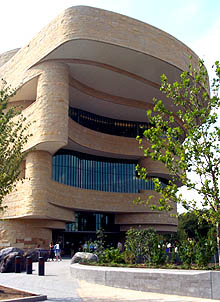By Paul Ruffins
The problem is that the permanent exhibits do not contain many accurate references to massacres, smallpox and other diseases carried by European settlers or broken agreements. One panel describes how early Spanish explorers held an Indian king for ransom but then strangled him to death after his people delivered the gold demanded for his release. The disappointment is that little in the museum communicates a powerful feeling of righteous anger. Nowhere is there a large, clear statement that the Americans who visit today are the heirs to a legacy of atrocity. Nothing screams out that the assault was 200 years longer than African slavery and as deadly as Adolf Hitler’s Final Solution.
After the opening, the Native American Times reported that Clyde H. Bellecourt, national executive director of the American Indian Movement (AIM), said, “They should have a wall to speak about the holocaust of the tribes who disappeared. They don’t say who was responsible for it. Our history is not being told.” AIM called for the museum to be renamed the National Holocaust Museum of the American Indian.
NMAI curators such as Tayac and Paul Chaat Smith, who wrote many of the historical labels, say the criticism hurt them but admit that some of it was justified. “No one here thinks we hit the nail right on the head,” says Tayac.
Chaat Smith sees the irony in the criticism. “The labels talk about the diseases that killed millions and assert that the Columbian encounter changed everything about the world we live in today,” he says, “but I’ve learned that most visitors don’t read labels and that subtlety is a waste of effort. We have a bitter joke that we ended up with the greatest story never told.”
How, after millions in research and years of consultation, could a museum on Native American history lack so much history? Chaat Smith says one explanation is the limitations of oral histories as a museum methodology.
“NMAI deliberately emphasized the voices of contemporary Native Americans,” he says. “However, like most people, they preferred to speak about their lived experience rather than historical atrocities that happened long before they were born.”
Kym Rice, the head of the museum studies department at George Washington University, supports his theory. Rice finds the major permanent exhibits disappointing and says, “I didn’t expect NMAI’s exhibitions to adhere so closely to what appears to be community-selected emphases, therefore ignoring historical context, colonialism and other factors in the process.”
Other explanations are more political. Harjo believes curators were intimidated into presenting a whitewashed perspective. “Proclaiming ‘We’re still here,’ means little without confronting the holocaust that killed 20 (million), 30 (million), maybe 40 million people,” she says. “That’s what makes it remarkable that any of us survived at all.”
The NMAI is a good museum, but it could be a great one. It isn't a great one yet.
When the museum's own staff admits it has a problem, then you know something's wrong. Almost every critic I've read has lambasted the museum for its lack of critical focus. People go to museums precisely to learn about the past. If they wanted feel-good stories about Indian country today, they could read a Native newspaper or magazine.
Now that the NMAI has tried its community-based approach, how about trying another approach? Continue using Native voices, but include the voices of activists, academics, artists, and others who are willing to look at the past. The museum's existence already proclaims the "we're still here" message, so the soft-focus exhibits are redundant.
For pictures of my visit to the NMAI, see Pix of My 2009 Washington DC Trip. For more on the subject, see NMAI Will Tell "Difficult" Stories, NMAI Not "Comfortable" with Negativity?, and Museums as Ethnic Advertising.


1 comment:
Instead of visiting the museum, people could just watch an episode of "The Lone Ranger" and let Tonto save them money and walk away with that traditional American "feel good" pat on the back!
I see a parallel between your Obama article above and this one. When Americans try to approach the indigenous people on any level, they do it from a "Wild West Buffalo Bill Cody" mentality. And it doesn't hurt to throw in a token native, as the guy with the headdress has proven, to remind everyone "Me, chief" and Obama chief too, now we, "chief to chief"?
Do the African American and Jewish museums paint the same cartoonish depictions as the NMAI or do they have wall sized photos, as natives do also, of mass graves and dead frozen bodies?
Post a Comment